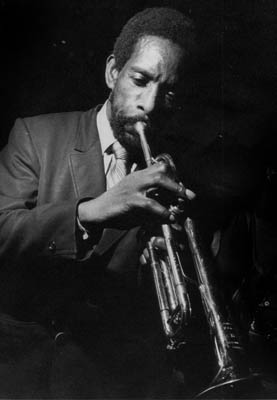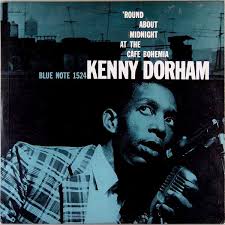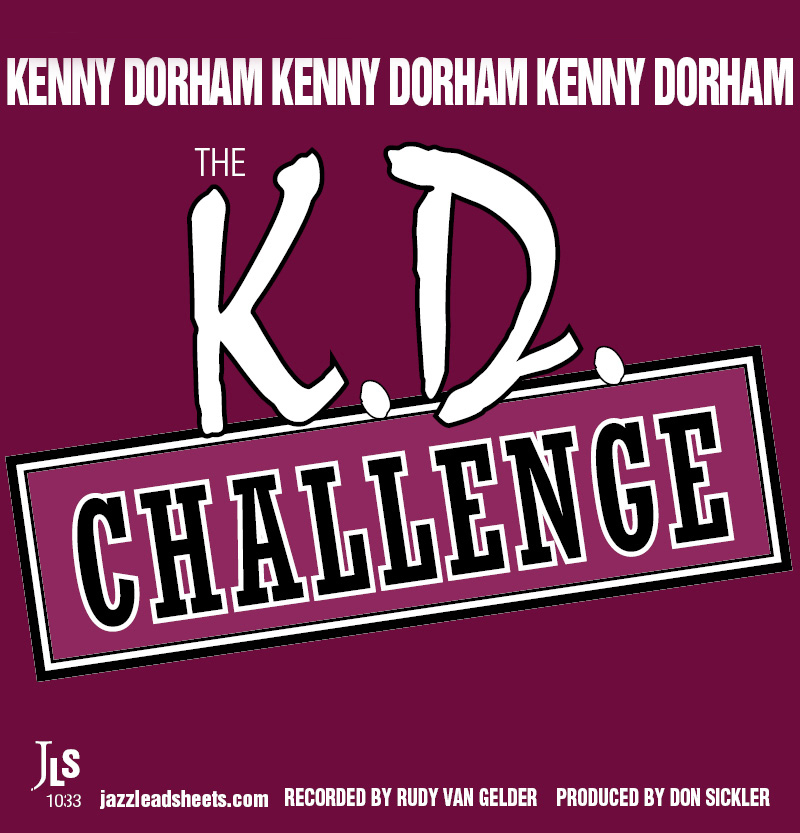Monaco – Kenny Dorham
The magic of this composition is fully realized in Kenny's multi-tempo arrangement. Everyone can explore this themselves through the Minus You tracks in our "K.D. Challenge" editions.
- Recording: Kenny Dorham - 'Round About Midnight At The Cafe Bohemia
- Recorded on: May 31, 1956
- Label: Blue Note (BLP 1524)
- Concert Key: F minor
- Vocal Range: , to
- Style: Latin/swing (medium)
- Trumpet - Kenny Dorham
- Tenor Sax - J.R. Monterose
- Guitar - Kenny Burrell
- Piano - Bobby Timmons
- Bass - Sam Jones
- Drums - Arthur Edgehill
0:00
0:00
Buy MP3
Video
- Description
- Historical Notes
- Solos
- Piano Corner
- Bass Corner
- Drum Corner
- Guitar Corner
- Inside & Beyond
- Minus You
We start our exploration of this wonderful K.D. composition with the two takes Kenny recorded on this live recording. Listening to our A section excerpts of both recorded takes (one after the other), you'll hear Kenny's two different interpretations of his A section melody.
master take CLIPA
alternate take CLIPB
Note from Don Sickler: In 1991 I did a sextet (three-horn) arrangement of Monaco for the album "Take One," T.S. Monk's first recording for the Blue Note label. I had listened closely to Kenny's two takes on his live quintet recording, and fortunately Kenny Dorham had also deposited his own carefully notated lead sheet of the 16-measure A section of Monaco at the Copyright Office in 1958, one year after his earlier publisher had registered a less accurate lead sheet. Kenny's lead sheet became the basis for the trumpet melody part for my sextet arrangement and the melody edition lead sheet for our "K.D. Challenge" Minus You tracks, which also contain the (B) and (C) sections of the composition.
Now, we've made available full melody transcriptions (the complete in and out melodies of both of Kenny's recorded takes), so you can study this master interpreting his own melody. Comparing these melody transcription editions with my lead sheet edition, which came from Kenny's manuscript, will give you further insight into creating your own melody interpretation. The piano, bass and drum editions for both recordings are the same.
In my original sextet arrangement and in our "K.D. Challenge" editions I expanded Kenny's original arrangement by adding horn exchanges with drums (8s). From Kenny's original recording you'll find that he gets out of the double time solo tempo ingeniously by immediately interjecting an eight-measure interlude consisting of "and-of-4" stop time hits with little drum setups, ending with a bar of dead silence to set up the return to the original Latin A section. In my arrangements, the drums continue to solo through the interlude, up to the dead stop.
Though this song may seem complex with its tempo changes and rhythm section figures, it is actually relatively simple for a Dorham composition. A song in F minor, its melody picks up exactly where the coda of Minor's Holiday leaves off. The mood is set by a Latin groove intro with a mysterious-sounding bass line, which continues on the first and last four measures of this 16-measure form; the middle eight measures are swinging. After this first chorus, the tempo doubles for an interlude or "bridge" with rhythm section stop-time. A variation of the A section melody is then played again in the same faster tempo, again with stop-time figures at the beginning and end. This section is also the solo form. The interlude which follows the solo section reintroduces stop-time. On Kenny's original recording, the tenor sax plays simple "pads" under the swung parts of the melody. I expanded this idea in my three-horn arrangement.
Note that the lead sheets available under each album cover are identical; if you click to order one, the checkmark will also appear by the part under the other album (click on the album cover to change views).
master take CLIPA
alternate take CLIPB
Note from Don Sickler: In 1991 I did a sextet (three-horn) arrangement of Monaco for the album "Take One," T.S. Monk's first recording for the Blue Note label. I had listened closely to Kenny's two takes on his live quintet recording, and fortunately Kenny Dorham had also deposited his own carefully notated lead sheet of the 16-measure A section of Monaco at the Copyright Office in 1958, one year after his earlier publisher had registered a less accurate lead sheet. Kenny's lead sheet became the basis for the trumpet melody part for my sextet arrangement and the melody edition lead sheet for our "K.D. Challenge" Minus You tracks, which also contain the (B) and (C) sections of the composition.
Now, we've made available full melody transcriptions (the complete in and out melodies of both of Kenny's recorded takes), so you can study this master interpreting his own melody. Comparing these melody transcription editions with my lead sheet edition, which came from Kenny's manuscript, will give you further insight into creating your own melody interpretation. The piano, bass and drum editions for both recordings are the same.
In my original sextet arrangement and in our "K.D. Challenge" editions I expanded Kenny's original arrangement by adding horn exchanges with drums (8s). From Kenny's original recording you'll find that he gets out of the double time solo tempo ingeniously by immediately interjecting an eight-measure interlude consisting of "and-of-4" stop time hits with little drum setups, ending with a bar of dead silence to set up the return to the original Latin A section. In my arrangements, the drums continue to solo through the interlude, up to the dead stop.
Though this song may seem complex with its tempo changes and rhythm section figures, it is actually relatively simple for a Dorham composition. A song in F minor, its melody picks up exactly where the coda of Minor's Holiday leaves off. The mood is set by a Latin groove intro with a mysterious-sounding bass line, which continues on the first and last four measures of this 16-measure form; the middle eight measures are swinging. After this first chorus, the tempo doubles for an interlude or "bridge" with rhythm section stop-time. A variation of the A section melody is then played again in the same faster tempo, again with stop-time figures at the beginning and end. This section is also the solo form. The interlude which follows the solo section reintroduces stop-time. On Kenny's original recording, the tenor sax plays simple "pads" under the swung parts of the melody. I expanded this idea in my three-horn arrangement.
Note that the lead sheets available under each album cover are identical; if you click to order one, the checkmark will also appear by the part under the other album (click on the album cover to change views).
"'Round About Midnight At The Cafe Bohemia" was recorded remotely by the legendary Rudy Van Gelder at The Cafe Bohemia in New York City.
Kenny's first recorded take of this composition [which became the alternate take] comes from the first set of the evening. Guitarist Kenny Burrell was added to the group starting in the second set, and in the third set they did Monaco again, where Burrell also joins the group for a solo. Burrell had just recorded his second album as a leader, "Introducing Kenny Burrell," over the previous two days.
Exactly one week after K.D. did the last session of his "Afro-Cuban" album for Blue Note, he recorded a new group called Kenny Dorham and the Jazz Prophets for the ABC Paramount label (April 4, 1956). This Monaco session, which was at the end of the next month, is this same new band, except that original pianist Dick Katz was replaced by Bobby Timmons (it was Bobby's first recording session). Kenny also introduced his tenor saxophonist J.R. Monterose to the Blue Note label with this session, leading to Blue Note giving J.R. his own session as a leader five months later. Drummer Arthur Edgehill's first recordings were also as a member of the Jazz Prophets. On November 9, 1956, Edgehill recorded Gigi Gryce's Transfiguration, on Mal Waldron's session. Edgehill's next session started several years of recording with tenor saxophonist Eddie "Lockjaw" Davis alongside organist Shirley Scott and bassist George Duvivier. The other member of K.D.'s Jazz Prophets is bassist Sam Jones, who was also introduced to the Blue Note label with this recording. Sam had recorded before K.D's Jazz Prophets, but only on little-known sessions under the leadership of saxophonist Paul Williams and bandleaders Tiny Bradshaw and Rufus Gore. After K.D.'s Blue Note introduction, Sam became a highly sought-after bassist. To help put Sam Jones in perspective, check him out on jazzleadsheets.com. Just type SAM JONES in the search box top right.
Monaco remains little-known and rarely recorded, with one notable exception being a version on T.S. Monk's 1991 album "Take One" arranged by jazzleadsheets.com's Don Sickler. Saxophonist Bobby Porcelli plays both on the T.S. Monk recording and our "K.D. Challenge" version.
Kenny's first recorded take of this composition [which became the alternate take] comes from the first set of the evening. Guitarist Kenny Burrell was added to the group starting in the second set, and in the third set they did Monaco again, where Burrell also joins the group for a solo. Burrell had just recorded his second album as a leader, "Introducing Kenny Burrell," over the previous two days.
Exactly one week after K.D. did the last session of his "Afro-Cuban" album for Blue Note, he recorded a new group called Kenny Dorham and the Jazz Prophets for the ABC Paramount label (April 4, 1956). This Monaco session, which was at the end of the next month, is this same new band, except that original pianist Dick Katz was replaced by Bobby Timmons (it was Bobby's first recording session). Kenny also introduced his tenor saxophonist J.R. Monterose to the Blue Note label with this session, leading to Blue Note giving J.R. his own session as a leader five months later. Drummer Arthur Edgehill's first recordings were also as a member of the Jazz Prophets. On November 9, 1956, Edgehill recorded Gigi Gryce's Transfiguration, on Mal Waldron's session. Edgehill's next session started several years of recording with tenor saxophonist Eddie "Lockjaw" Davis alongside organist Shirley Scott and bassist George Duvivier. The other member of K.D.'s Jazz Prophets is bassist Sam Jones, who was also introduced to the Blue Note label with this recording. Sam had recorded before K.D's Jazz Prophets, but only on little-known sessions under the leadership of saxophonist Paul Williams and bandleaders Tiny Bradshaw and Rufus Gore. After K.D.'s Blue Note introduction, Sam became a highly sought-after bassist. To help put Sam Jones in perspective, check him out on jazzleadsheets.com. Just type SAM JONES in the search box top right.
Monaco remains little-known and rarely recorded, with one notable exception being a version on T.S. Monk's 1991 album "Take One" arranged by jazzleadsheets.com's Don Sickler. Saxophonist Bobby Porcelli plays both on the T.S. Monk recording and our "K.D. Challenge" version.
Related Songs
Email Send Monaco to a friend
Send this page to a friend via email. Add your name or email in the first field. In the second, add one or more email addresses, separated by a comma.
- Recording: Don Sickler - The K.D. Challenge
- Recorded on: October 6, 2001
- Label: jazzleadsheets.com (JLS 1033)
- Concert Key: F minor, No key center
- Vocal Range: , to
- Style: Latin/swing
- Trumpet - Don Sickler
- Alto Sax - Bobby Porcelli
- Piano - Cecilia Coleman
- Bass - Tim Givens
- Drums - Vince Cherico
Video
- Description
- Historical Notes
- Solos
- Piano Corner
- Bass Corner
- Drum Corner
- Guitar Corner
- Inside & Beyond
- Minus You
The arrangement on this recording is the same as on Dorham's original version, at least with respect to the rhythm section. There is no two-horn arrangement here; the trumpet has the entire melody on the in and out heads. As with many other songs in our "K.D. Challenge" series, the rhythm section parts have the melody notated on a separate staff above the part.
To learn why we think Kenny Dorham's music is so important, click About The K.D. Challenge.
To learn why we think Kenny Dorham's music is so important, click About The K.D. Challenge.
"The K.D. Challenge" was recorded at the legendary Van Gelder Studio in Englewood Cliffs.
Trumpeter/arranger Don Sickler used Kenny's own copyrighted lead sheet as the basis for his sextet arrangement, which was recorded by the T.S. Monk sextet on their first album for Blue Note Records in 1991. Don then made new parts for the "K.D. Challenge" recording featured here, so all musicians can play along with the Minus You tracks.
Trumpeter/arranger Don Sickler used Kenny's own copyrighted lead sheet as the basis for his sextet arrangement, which was recorded by the T.S. Monk sextet on their first album for Blue Note Records in 1991. Don then made new parts for the "K.D. Challenge" recording featured here, so all musicians can play along with the Minus You tracks.
Monaco starts at a medium tempo, then goes into double time and becomes more of a medium-up piece. The melody also transitions back and forth from Latin to swing. Though this song may seem complex with its tempo changes and rhythm section figures, it is actually relatively simple for a Dorham composition. This Minus You track gives you, the drummer, a chance to trade 8s and practice some solo material of your own.
To learn why we think Kenny Dorham's music is so important, click About The K.D. Challenge.
To learn why we think Kenny Dorham's music is so important, click About The K.D. Challenge.
Exclusive Minus You audio tracks Become part of the band—separate MP3 tracks available for each instrument. Note that the tempo changes (to double) within the melody. The original tempo returns at the D.S.
Form of all Minus You tracks:
-- intro
-- melody (includes tempo change)
-- alto sax solo 4 choruses
-- trumpet solo 4 choruses
-- horns trade 8s with drums 4 choruses
-- out melody
-- coda
mp3 minus melody
-- tacet for the intro
-- play the melody
-- solo 8 choruses
-- trade 8s with drums 4 choruses
-- play the out melody and coda
mp3 minus Piano
-- count off sets up the intro
-- play figures/comp for the intro and melody
-- comp for the alto sax and trumpet solos 4 choruses each
-- comp for horns trading 8s with drums 4 choruses
-- play figures/comp for the out melody and coda
mp3 minus Bass
-- count off sets up the intro
-- play figures/walk for the intro and melody
-- walk for the alto sax and trumpet solos 4 choruses each
-- walk for horns trading 8s with drums 4 choruses
-- play figures/walk for the out melody and coda
mp3 minus Drums
-- count off sets up the intro
-- play figures/comp for the intro and melody
-- comp for the alto sax and trumpet solos 4 choruses each
-- trade 8s with alto and trumpet (alto first) 4 choruses CLIP snaps added during the trading
-- play figures/comp for the out melody and coda
mp3 Bass & Drums only - to feature piano, guitar, vibes, or any melodic instrument that likes to play without harmonic accompaniment
-- count off sets up the melody
-- play the melody
-- solo 8 choruses
-- trade 8s with drums 4 choruses
-- play the out melody and coda
Form of all Minus You tracks:
-- intro
-- melody (includes tempo change)
-- alto sax solo 4 choruses
-- trumpet solo 4 choruses
-- horns trade 8s with drums 4 choruses
-- out melody
-- coda
mp3 minus melody
-- tacet for the intro
-- play the melody
-- solo 8 choruses
-- trade 8s with drums 4 choruses
-- play the out melody and coda
mp3 minus Piano
-- count off sets up the intro
-- play figures/comp for the intro and melody
-- comp for the alto sax and trumpet solos 4 choruses each
-- comp for horns trading 8s with drums 4 choruses
-- play figures/comp for the out melody and coda
mp3 minus Bass
-- count off sets up the intro
-- play figures/walk for the intro and melody
-- walk for the alto sax and trumpet solos 4 choruses each
-- walk for horns trading 8s with drums 4 choruses
-- play figures/walk for the out melody and coda
mp3 minus Drums
-- count off sets up the intro
-- play figures/comp for the intro and melody
-- comp for the alto sax and trumpet solos 4 choruses each
-- trade 8s with alto and trumpet (alto first) 4 choruses CLIP snaps added during the trading
-- play figures/comp for the out melody and coda
mp3 Bass & Drums only - to feature piano, guitar, vibes, or any melodic instrument that likes to play without harmonic accompaniment
-- count off sets up the melody
-- play the melody
-- solo 8 choruses
-- trade 8s with drums 4 choruses
-- play the out melody and coda
Related Songs
Email Send Monaco to a friend
Send this page to a friend via email. Add your name or email in the first field. In the second, add one or more email addresses, separated by a comma.

Kenny Dorham
August 30, 1924 – December 15, 1972
August 30, 2025, is Kenny Dorham's 101st birthday: jazzleadsheets.com has added many new K.D. compositions. Jazz At Lincoln Center has dedicated three late-night sets to Kenny's music, played with love by young musicians who want his music to live on. Join in, play K.D. music! Read more...
There was a problem.
...


